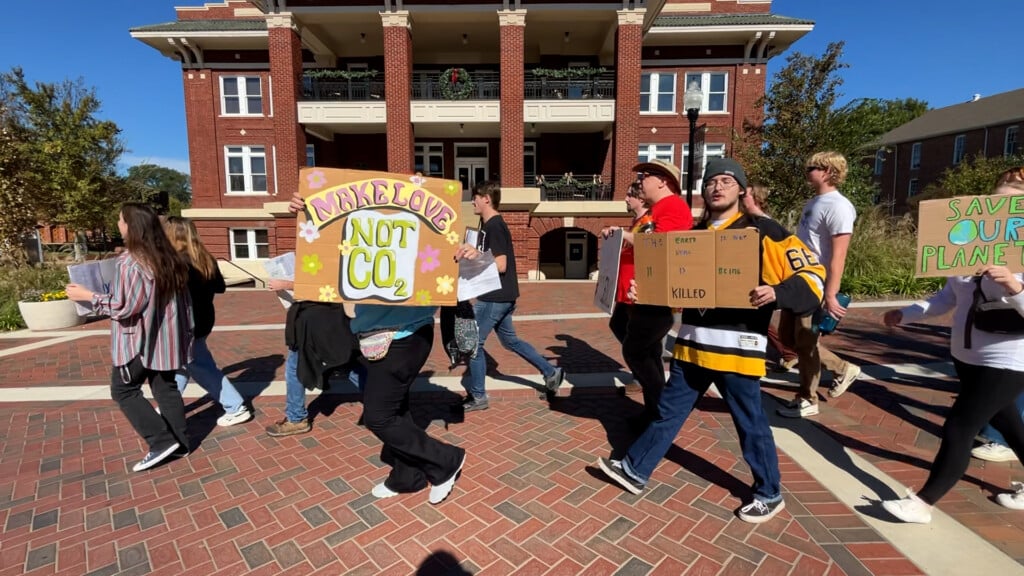Keenum Optimistic in MSU Address
STARKVILLE, Miss. — During his fall address to faculty Wednesday [Sept. 11], MSU President Mark E. Keenum shared a new level of optimism, noting that for the first year since he began his presidency in January 2009, the university’s state funding has not been cut.
While he discussed numerous ongoing challenges, Keenum told faculty he believes “our long-term prospects as a university today look better than ever before.”
He said an increase of about 0.7 percent in state-appropriated funding, which equates to more than $620,000 for general operations, “is a welcome change from what we’ve gone through during the Great Recession that began in 2008.”
Keenum said the university had weathered hard economic times and a multi-year cut in state support by becoming more efficient and by significantly increasing revenue from tuition, through both higher enrollments and higher rates.
He said while fiscal year 2014 will be MSU’s best year for state funding in a long time, the fact remains that funding for Mississippi universities is still well below what it was at the start of the recession five years ago.
“Total state appropriations to IHL for fiscal year 2014, which began in July, are nearly $70 million less than at the beginning of fiscal year 2009,” Keenum said. He explained that both in Mississippi and across the country, costs of public higher education have been shifting from state governments to students and their families.
“That is a trend that cannot continue,” he said.
He noted that while MSU has raised tuition rates, the university is among the least expensive in the Southeastern Conference and also less expensive than many regional universities in adjacent states.
“We’re still a great bargain, but we can’t escape the fact that college costs are a great concern to many Mississippi families,” he said. “We look forward to the time when adequate state support will alleviate the need for continuing tuition hikes.”
Keenum said that IHL officials and university presidents will appear next week before the Joint Legislative Budget Committee to make their case for funding needs, with a system-wide top priority being improved faculty salaries.
Keenum said faculty salaries at MSU increased for the third year in a row, despite the lack of any state appropriation for that purpose. However, compared with other peer institutions in the South, he said MSU faculty salaries need to increase to remain competitive.
The president emphasized that enrollment growth is still a critical goal to the university. In addition to meeting the state’s need for more college-educated workers, Keenum said continued enrollment growth is important to the university’s financial health.
“To have the resources to enhance academic quality, improve the learning environment, and reward and retain faculty, we need to continue to grow, at least to our target of 22,000 over the next few years,” he said.
This fall, MSU’s enrollment is above 20,000 for the third year in a row, and Keenum noted the incoming freshman class is the largest in university history, also bringing the highest average ACT score in university history.
Keenum said as the university works to enhance all aspects, he plans to see Mississippi State strengthen and solidify its role as a premier, student-centered research university.
Ranked this year by the National Science Foundation as a top research and development university, MSU is in the top 10 for agricultural sciences research and in the top 50 for engineering, computer science, social sciences, and humanities.
“All of this means that Mississippi State is a major factor in the state’s economic development efforts,” Keenum said. “To cite just one recent example, our university had a direct role in convincing Yokohama Tire Corporation to locate a new $300 million commercial tire plant in adjacent Clay County. Our National Strategic Planning and Analysis Research Center, the Bagley College of Engineering, and the Center for Advanced Vehicular Systems were particularly influential,” he said.
He went on to tell faculty that the university’s progress over the past five years in all three core mission areas of teaching, research and service, during a period of declining state and federal support, “is a testament to the resourcefulness and determination of our faculty and staff to the fundamental quality of this university.”
Keenum said that among additional reasons to feel good about MSU’s future is the growing support and involvement of the university’s 125,000 alumni. He said alumni and friends of the university have contributed and pledged more than $80 million for three years in a row, including a recent $3 million-plus gift from 1962 graduate Niles Moseley and his wife Mary Lyn to the MSU Promise Program, which provides tuition assistance and counseling to low-income freshmen and community college transfers.
“My optimism is not of the restrained or cautious variety. I’m excited about what the future holds for Mississippi State University. I can’t wait to see what the next five years will bring,” Keenum said.
Among his updates, he also outlined the status of numerous construction projects developing on campus, including the renovation of Lee Hall, expected to be complete in spring 2014; construction of a classroom building with parking behind the YMCA Building to be complete in early 2015; expansion of Davis Wade Stadium to be finished by the start of the 2014 football season; renovation of the YMCA Building; construction of a classroom addition to the Wise Center; and campus-wide retrofitting of interior lighting, which Keenum said will save millions of dollars in energy costs over the next several years.





Leave a Reply